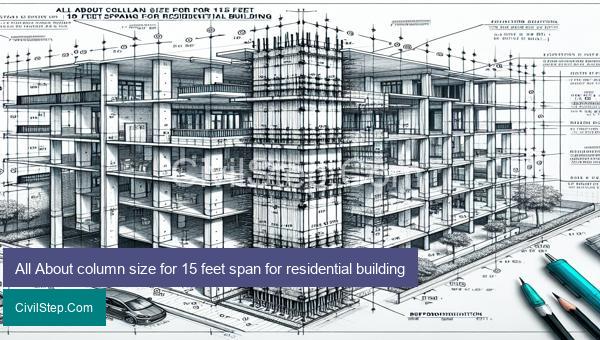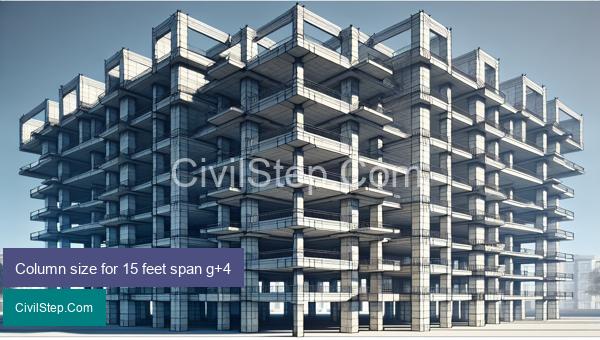
When designing a residential building, every aspect must be carefully considered, including the size of the columns. These structural supports are essential for safely distributing the weight of the structure and ensuring its stability. However, when it comes to the specific dimensions of columns for a 15 feet span, there are several factors that must be taken into account. In this article, we will delve into all the important information regarding column size for a 15 feet span in residential buildings, including the various types of columns, their structural requirements, and tips for ensuring their strength and durability. Whether you are a homeowner, architect, or engineer, understanding the column size for a 15 feet span is crucial for the successful construction of any residential building.
What is column size for 15 feet span for residential building

Column size is an important consideration for any construction project, especially for residential buildings with a 15 feet span. A column is a vertical structural element that transfers the weight of the building to the foundation. The size of the column depends on various factors such as the load it needs to support, the height of the building, and the span of the structure.
In a residential building with a 15 feet span, the column size will mainly depend on the load it needs to carry. The loads that are transferred to the columns include the weight of the building, the weight of the roof, and the live loads such as furnishings and people. In general, the heavier the load, the larger the column size needs to be.
Another important factor that determines the column size is the height of the building. As the height of the building increases, the load on the column also increases, and thus a larger column size is required. The span of the structure also affects the column size as it determines the distance between columns, which can impact the load distribution.
Based on the building codes and standards, the minimum column size for a 15 feet span in a residential building is typically 9 inches by 9 inches. However, this size may vary depending on the material used for construction, the type of foundation, and the number of floors. Additionally, the type of column such as reinforced concrete or steel will also influence the size of the column.
Apart from the load and height considerations, aesthetic and architectural requirements may also play a role in determining the column size. For instance, in modern homes, slim columns with a minimum thickness are preferred to give a sleek and modern look. However, in traditional or colonial-style homes, thicker and more decorative columns may be used.
In conclusion, the column size for a residential building with a 15 feet span will depend on various factors such as load, height, span, material, and architectural preferences. It is crucial to carefully determine the appropriate column size to ensure the structural stability and safety of the building. It is always best to consult a structural engineer or an architecture professional to determine the most suitable column size for a specific project.
Column size for 15 feet span g+1

As a civil engineer, one of the primary tasks in any construction project is designing the structural elements such as columns. These vertical elements play a crucial role in supporting the weight of the building and transferring the load to the foundation.
When it comes to designing a column for a 15 feet span, several factors need to be considered, including the type of construction, type of material, and the expected load. In this case, we will explore the column size for a 15 feet span for a G+1 (ground floor plus one) building.
The first step in determining the size of the column is to identify the load it needs to carry. For a G+1 building, we can assume a live load of 3kN/m2 for the ground floor and 2kN/m2 for the first floor. This takes into account the weight of the structures, occupants, and any furniture or fixtures. We also need to consider the self-weight of the column, which is usually around 10% of the live load.
Next, we need to determine the type of construction. For a G+1 building, we can assume it will be a reinforced concrete frame structure. This type of construction is suitable for low-rise buildings and provides excellent structural stability and strength. Based on the American Concrete Institute (ACI) standards, we can use the following formula to calculate the required minimum cross-sectional area for the column:
A = (Pu + Mu)/(0.4f’c + 0.67fy)
Where,
A = Cross-sectional area of the column
Pu = Ultimate axial load on the column
Mu = Ultimate moment on the column
f’c = Compressive strength of concrete
fy = Yield strength of reinforcement
For a 15 feet span, the ultimate moment can be calculated as:
Mu = wl2/10 = (3kN/m2 x 4.5m x 4.5m)/10 = 6.75kNm
The ultimate axial load can be determined by considering the worst-case scenario, which is when all the load on the column is concentrated at the center.
Pu = 1.2DL + 1.6LL = (1.2x 45kN) + (1.6x 30kN) = 96kN
Assuming a compressive strength of concrete of 20MPa and a yield strength of reinforcement of 415MPa, we can calculate the required minimum cross-sectional area as follows:
A = (96kN + 6.75kNm)/(0.4x 20MPa + 0.67x 415MPa) = 329.6mm2
We can then refer to standard column size charts to select the appropriate cross-sectional area for the column. In this case, we can use a 300mm x 500mm rectangular column or a 450mm diameter circular column.
In addition to these calculations, we also need to account for any architectural constraints and the spacing between columns. The spacing should be such that it provides sufficient stability to the building.
In conclusion, the column size for a 15 feet span G+1 building will depend on the ultimate moment and axial load, type of construction, and type of material used. The calculations and selection of the appropriate cross-sectional area should be done according to the applicable building codes and standards to ensure a safe and stable structure.
Column size for 15 feet span g+2

When designing a column size for a 15 feet span in a G+2 building, there are a few factors to consider. These include the type of building materials being used, the load bearing capacity of the column, and the anticipated load the column will have to support.
Firstly, the type of building material will play a significant role in determining the column size. In most cases, reinforced concrete (RC) is used for columns in G+2 buildings. This is because RC provides enough strength and stability to support the weight of the structure above.
Secondly, the load bearing capacity of the column must be taken into account. The column must be designed to withstand both the dead load and live load of the structure. Dead load refers to the weight of the building materials, while live load refers to the weight of the people and furniture inside the building. The column must be able to carry this weight without experiencing excessive deflection or deformation.
In terms of calculations, the recommended guidelines for column size state that the minimum size of a square column should be 9 inches x 9 inches, while a circular column should have a diameter of at least 8 inches. However, for a 15 feet span, it is advisable to use a larger column size to provide more stability and strength. For a G+2 building, a square column size of 12 inches x 12 inches or a circular column with a diameter of 10 inches would be more suitable.
Additionally, the spacing of the columns must also be considered. For a 15 feet span, columns should ideally be placed at intervals of 12 feet. This provides more support and prevents excessive bending of the beams and slabs.
It is also important to note that the column size and spacing will vary depending on the location and purpose of the building. For example, if the building is located in an earthquake-prone area, the column size and spacing may need to be increased to provide more stability and resistance to lateral forces.
In conclusion, when designing a column size for a 15 feet span in a G+2 building, it is crucial to consider the building material, load bearing capacity, and intended use of the structure. It is always recommended to consult with a structural engineer to ensure the appropriate column size is selected to ensure the safety and stability of the building.
Column size for 15 feet span g+3

When designing a building, one of the key considerations is the size and dimensions of the columns that will support the structure. For a 15 feet span in a building with ground floor plus three additional floors (G+3), the column sizes will vary depending on the type of construction materials used and the load-bearing capacity required.
In general, columns are typically designed based on the total dead load and live load of the structure, including the weight of the materials, occupants, and any additional loads such as furniture and equipment. The column sizes also take into account the type of foundation used and the soil conditions of the site.
For a 15 feet span in a G+3 building, the standard column sizes may range from 9 inches by 12 inches to 12 inches by 18 inches. However, the specific size may vary based on the following factors:
1. Building materials: The type of materials used for construction can affect the size of columns. For example, reinforced concrete (RC) columns will have different dimensions compared to steel or wooden columns of the same load-bearing capacity.
2. Building design and layout: The layout of the building, such as the location of walls and beams, can influence the size of the columns. If walls are placed in close proximity to columns, it may require thicker and stronger columns to support the load effectively.
3. Type of building: The type of building being constructed can also impact the size of columns. For instance, commercial or industrial buildings may require larger and stronger columns compared to residential buildings.
4. Building codes and regulations: The local building codes and regulations set by authorities will dictate the minimum size and load-bearing capacity of columns for a G+3 building in a specific area.
5. Soil conditions and foundation type: The soil conditions of the site and the type of foundation used will also impact the column size. If the soil is weak or unstable, thicker and stronger columns may be required to distribute the load effectively.
In conclusion, the column size for a 15 feet span G+3 building will depend on various factors such as the materials used, building design, local regulations, and soil conditions. It is essential to consult with a structural engineer to determine the most suitable column size for the specific project to ensure the safety and stability of the structure.
Column size for 15 feet span g+4

When constructing a building, one of the key elements to consider is the size and design of its columns. The columns are vertical structural elements that transmit the weight of the building and its contents to the foundation. In this article, we will discuss the column size for a 15 feet span building with a ground plus four floors (G+4).
Before determining the column size, it is important to understand the loads that the columns will be subjected to. The primary load on the columns is the weight of the building itself, also known as dead load. This includes all the structural elements such as beams, slabs, and walls. The columns also need to resist live loads, which include the weight of the people, furniture, and equipment inside the building. Additionally, columns must be designed to withstand horizontal forces such as wind and earthquake loads.
Based on the design requirements and building codes, the general rule of thumb for column spacing in a G+4 building is typically 5 to 6 meters. For a 15 feet span, this would result in 3 columns per floor. However, the spacing may vary depending on the specific building layout and design.
Now, let’s take a closer look at the column size for a 15 feet span in a G+4 building. Considering the number of columns per floor and the load-bearing capacity of the soil, we can determine the minimum size for the columns. For a 15 feet span, square columns with a dimension of 12 inches by 12 inches would be suitable. This size allows for the columns to adequately support both the dead and live loads.
Another factor to consider when determining the column size is the height of the building. As the building height increases, there is an increase in the load on the columns. Therefore, for a G+4 building, the columns on the lower floors may need to be slightly larger in size compared to the columns on the upper floors.
Apart from the size, the type of material used for the columns also plays a significant role in their stability and load-bearing capacity. Steel and reinforced concrete are the most commonly used materials for columns in G+4 buildings. Steel columns are more slender and take up less space, but they are more expensive compared to concrete columns. On the other hand, concrete columns may require a larger size to handle the same load as steel columns, but they are relatively more affordable.
In conclusion, for a 15 feet span G+4 building, the minimum size for the columns would be 12 inches by 12 inches. However, the column size may vary based on the specific design and layout of the building as well as other factors such as soil type, building height, and material used. It is crucial to consult with a professional structural engineer to ensure that the columns are appropriately sized and designed for the specific building project.
Column size for 15 feet span g+5

The size of columns for 15 feet span in a G+5 (Ground plus 5 floors) building is an important factor to consider in the structural design process. The columns, or vertical support members, play a crucial role in transferring the weight of the building to its foundation and ensuring the stability of the structure.
For a 15 feet span, the ideal column size would depend on several factors such as the building height, floor loads, and the type of construction materials used. However, based on the building code and standard practice, the minimum size for a column in a G+5 building would be 9 inches by 12 inches (9”x12”).
This size is suitable for a normal residential or commercial building with a height of up to 60 feet. It is also sufficient to support the standard floor loads, including the weight of the walls, floors, and live loads such as furniture and people. The 9”x12” size would also be suitable for concrete framed structures with beams and slabs.
However, if the building height is more than 60 feet or if the structure experiences higher floor loads due to heavy equipment or machinery, the size of the columns may need to be increased. This can be done by increasing the dimensions of the column or by using reinforced concrete with steel bars.
In some cases, the columns may also need to be spaced closer together to provide additional support. For a 15 feet span, the spacing between columns should not exceed 14 feet to ensure structural stability. It is also recommended to have a minimum of two columns along the shorter dimension and three columns along the longer dimension of the building.
In addition to the size and spacing of the columns, proper reinforcement is also crucial for the structural integrity of the building. The columns should be reinforced with steel bars, also known as rebars, to withstand tension and prevent buckling. The percentage of reinforcement bars required will depend on the structural design and the load-bearing capacity of the concrete.
In conclusion, for a 15 feet span in a G+5 building, the minimum size for columns should be 9 inches by 12 inches (9”x12”). The columns should also be spaced no more than 14 feet apart and properly reinforced with steel bars. However, it is always recommended to consult with a structural engineer to determine the precise column size and reinforcement requirements based on the specific details of the building.
Conclusion
In conclusion, selecting the appropriate column size for a 15 feet span in a residential building is a critical decision that can impact the structural integrity and safety of the entire structure. Factors such as the type of material, load-bearing capacity, and column spacing should be carefully considered before making a decision. It is essential to consult with a structural engineer to ensure that the chosen column size is suitable for the specific building and meets all safety standards and codes. With proper planning and expert guidance, the column size can be optimized to provide adequate support and stability for the building, ultimately ensuring the safety and longevity of the structure.
